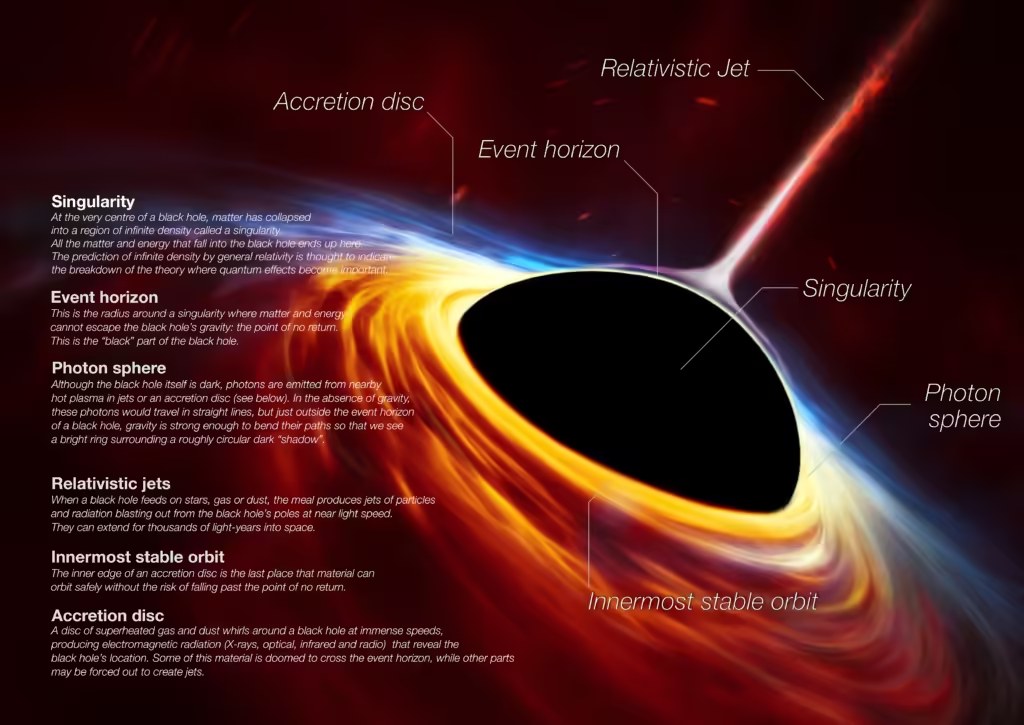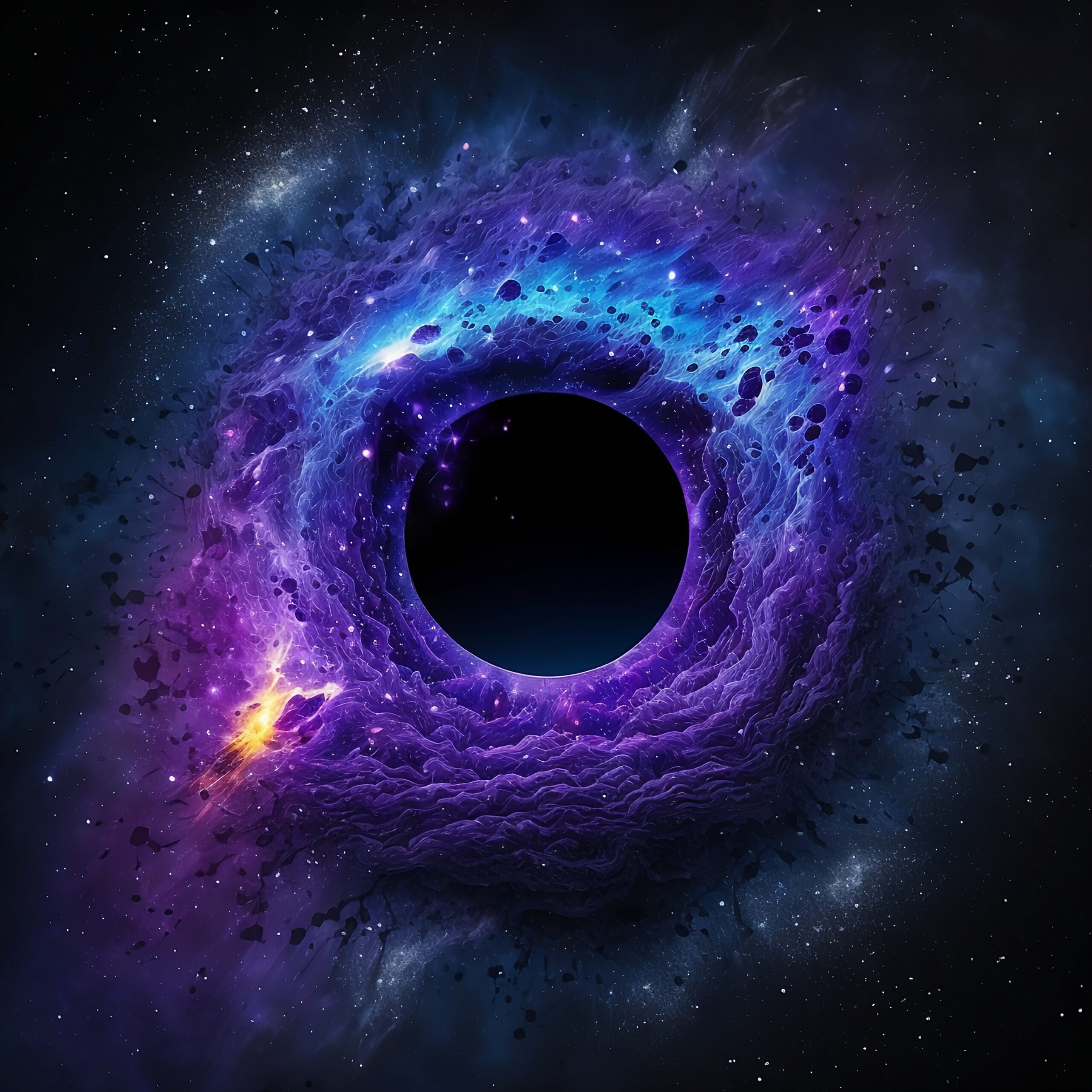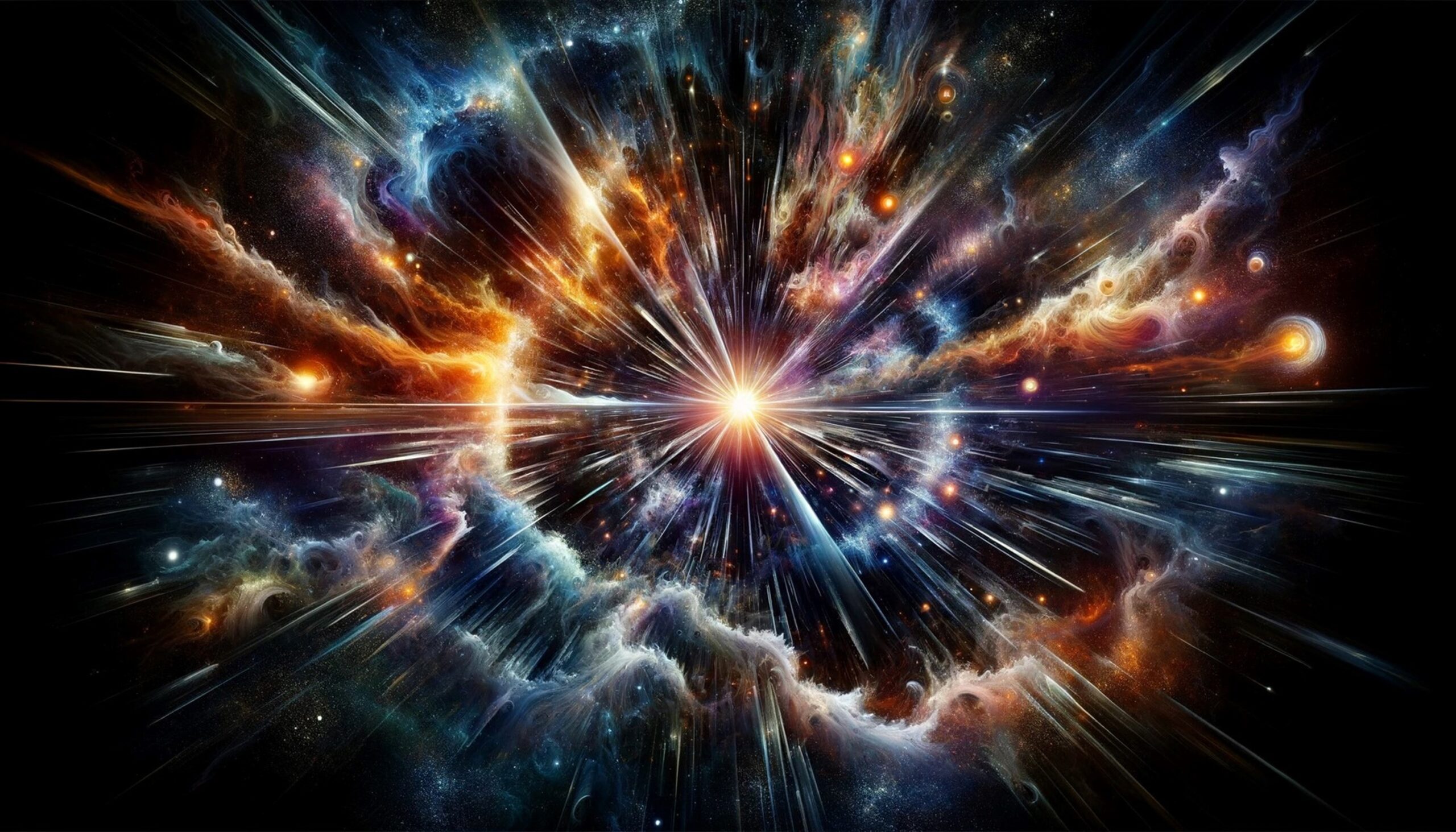Introduction
Black holes are some of the most interesting and mysterious things in the universe. Both scientists and the public are fascinated by them. A black hole is a place in space where the gravity is so strong that nothing can escape, not even light. This happens when a huge amount of matter gets squeezed into a tiny space, creating a powerful pull. Black holes usually form when massive stars die and collapse under their own gravity, but there are other ways they can be created too.
The edge of a black hole is called the event horizon. Once something crosses this line, it can’t escape. At the center of the black hole is a spot called a singularity, where everything is squeezed into infinite density. In this area, the normal laws of physics no longer work as we understand them.
Event Horizon
The event horizon is an important idea when talking about black holes. It’s the boundary around a black hole, and once something crosses it, not even light can escape. Since light is the fastest thing in the universe, this means that after anything crosses the event horizon, it’s trapped by the black hole’s strong gravity forever. This makes it impossible to see or reach from the outside.
Why is it called the “point of no return”?:
The event horizon is often called the “point of no return” because once something goes past this boundary, it can’t escape the black hole’s gravity. This applies to everything, including matter and radiation, which means that any information about what falls in is lost to anyone outside. Even if you could travel at the speed of light, you still wouldn’t be able to escape if you were inside the event horizon.
To someone watching from the outside, when an object gets close to the event horizon, it looks like it slows down. This is because of a effect called gravitational time dilation. From this viewpoint, the object never fully crosses the event horizon; it seems to “freeze” and gradually disappear as its light shifts to lower frequencies, making it look redder. However, for the object that is falling in, it would pass the event horizon without any problems and keep moving toward the center of the black hole.

Page URL: https://commons.wikimedia.org/wiki/
Attribution: European Southern Observatory – ESO, CC BY 4.0 https://creativecommons.org/licenses/by/4.0, via Wikimedia Commons
How does the event horizon form?:
The event horizon forms because the escape velocity—how fast something needs to go to escape a black hole’s gravity—equals the speed of light at this boundary. For smaller objects like planets or stars, escape velocity depends on their mass and size. But for a black hole, the mass is packed into a tiny space, making the escape velocity at the event horizon greater than the speed of light. This means nothing can escape from inside the event horizon.
So, the event horizon is the outer edge of a black hole’s powerful gravitational pull. Once something crosses this boundary, it falls into a part of space that we can’t understand or see from the outside. This makes the event horizon one of the most fascinating and mysterious features of black holes in astrophysics.
What Happens Beyond the Event Horizon?
Beyond the event horizon of a black hole is one of the biggest mysteries in modern physics. Because light can’t escape from this area, we can’t observe or get direct information about what happens there. This lack of data has led to a lot of guessing and theories, but no clear answers.
Once an object crosses the event horizon, it becomes disconnected from the outside universe. All information about its condition is lost, which leads to the “information paradox.” This raises deep questions about reality and the laws of physics. Physicists and cosmologists can only make educated guesses based on current theories, but we can’t confirm these ideas through observations.
The Singularity:
At the very center of a black hole is the singularity, a point where gravity becomes infinitely strong and spacetime is curved to an extreme.
Infinite Density: As matter falls into the black hole, it gets squeezed into an incredibly tiny space at the singularity. The density of this matter theoretically becomes infinite, which challenges our understanding of matter and energy.
Spacetime Curvature: The gravitational force at the singularity is so powerful that it distorts spacetime beyond imagination. At this point, our usual ideas of time and space no longer make sense.
Lack of Predictability: Because of the infinite density and extreme curvature of spacetime, it’s very hard to predict how matter behaves at the singularity. Current scientific theories can’t fully explain what happens there.
Life Beyond the Event Horizon
The mysteries of black holes have sparked many theories about what might be beyond the event horizon, including the possibility of life in forms we can’t yet imagine. Here are three interesting theories that explore these ideas:
Theory 1: Alternate Universes (Wormholes)
One of the most intriguing ideas in theoretical physics is that black holes might serve as gateways to other universes or connect different parts of our own universe through wormholes. Wormholes are hypothetical passages through spacetime that could create shortcuts between faraway points.
Gateway to Other Universes: Some theories propose that if a black hole connects to another area of spacetime, it could act as a portal to an alternate universe with different physical laws. In such a universe, the conditions for life could be very different from ours, potentially allowing for completely different forms of life based on principles we don’t yet understand.
Multiverse Theory: According to the multiverse theory, which suggests there are many, maybe even infinite, universes, black holes could serve as pathways between these different universes. Each universe might have its own set of physical constants and laws, creating unique environments where life could exist in forms completely alien to us.

Theory 2: Quantum Mechanics and Black Holes
Quantum mechanics provides a very different view of the universe, and its ideas may help us understand black holes and the possibility of life.
Holographic Principle: The holographic principle suggests that all the information in a volume of space can be represented on a two-dimensional surface. This means that the information about everything that falls into a black hole might be stored at the event horizon, possibly encoded in a way we don’t yet grasp. If this is true, it could indicate that the inside of a black hole isn’t completely lost, and some quantum states could still exist.
Quantum Life Forms: If quantum mechanics allows for the preservation of information, it leads to interesting questions about what existence could be like inside black holes. Life might exist at a quantum level, following quantum rules instead of the classical physics we know. These forms of life could operate under principles that are completely different from our understanding, existing in a way that isn’t limited by our usual ideas of biology.
Theory 3: Exotic Life Forms
The extreme conditions found near and inside black holes challenge our understanding of life and biology. Some speculative theories suggest that life could take forms that are very different from what we know.
Non-Carbon-Based Life: The idea of exotic life forms questions the assumption that all life must be carbon-based and dependent on water. In the harsh conditions of a black hole, other types of molecular structures might emerge that could support life. This could involve unusual chemistry based on elements like silicon or others that can thrive in high-energy environments.
Energy-Based Life: Some theorists have proposed the existence of energy-based life forms that don’t rely on traditional biological structures. Instead of depending on physical matter, these life forms might exist as patterns of energy or information. In the powerful gravitational and electromagnetic fields near black holes, these energy-based entities could interact with their surroundings in ways that we can’t fully understand.
Conclusion
While the idea of life existing beyond the event horizon of a black hole is still purely speculative, these theories help broaden our understanding of what might be possible. The relationship between black holes, quantum mechanics, and different forms of existence challenges our current ideas about life and pushes us to think beyond our biological limits. As we continue to learn more about physics and the universe, our theories about what could exist beyond the mysterious boundaries of black holes will evolve as well.
Share the knowledge with

